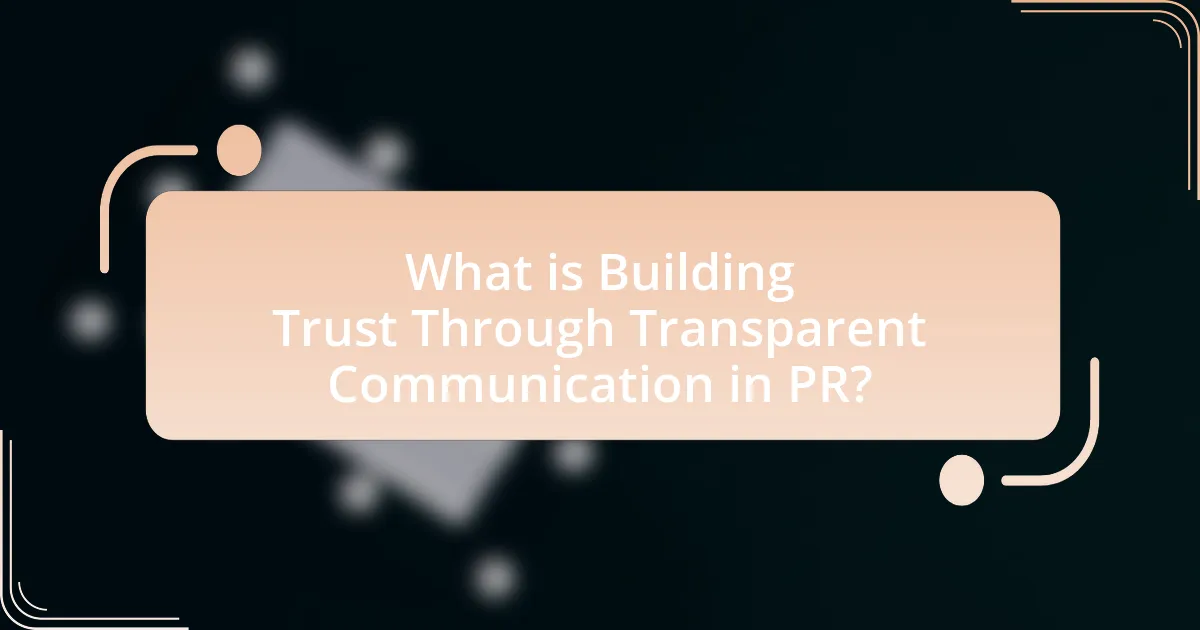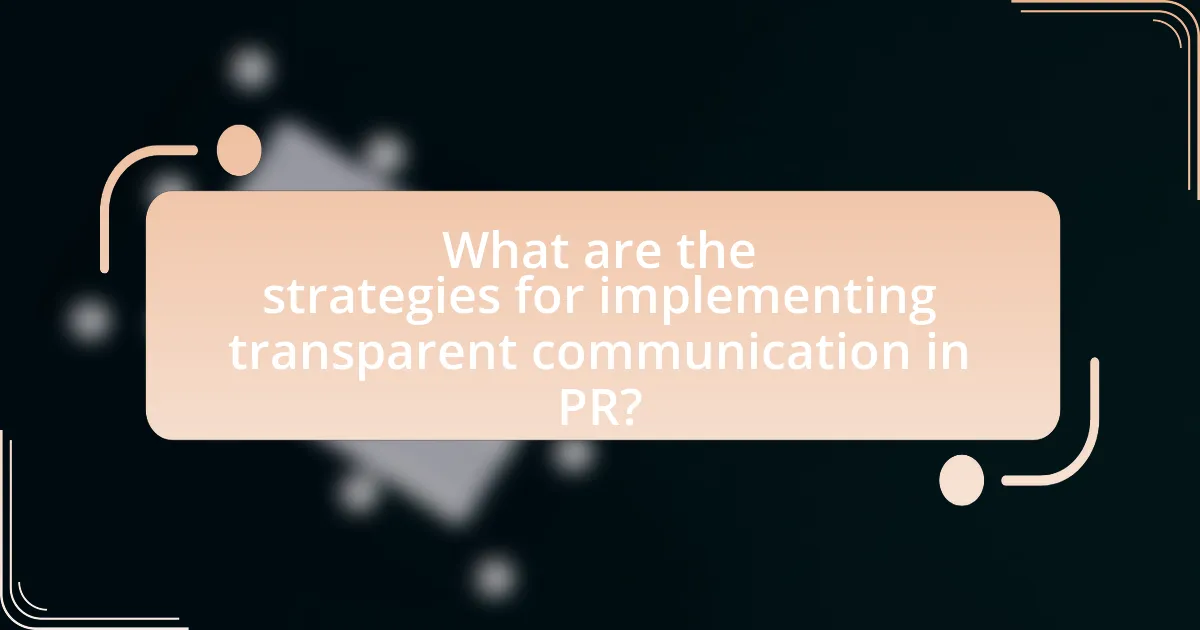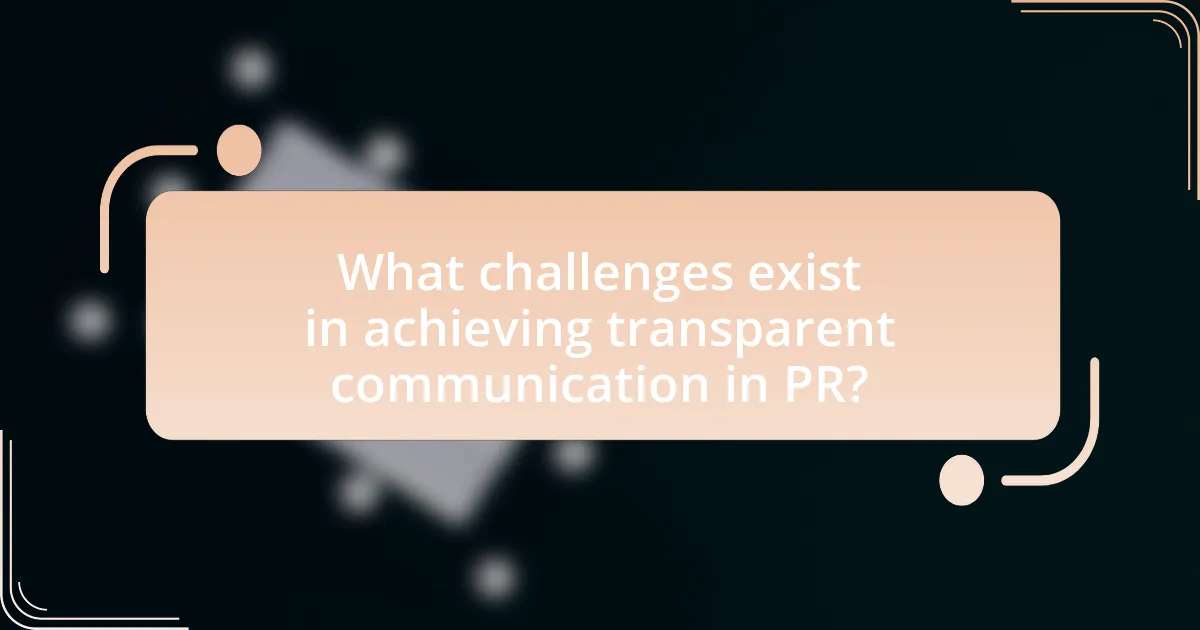Building trust through transparent communication in public relations (PR) is essential for fostering credibility and strengthening relationships between organizations and their stakeholders. The article outlines how transparent communication, characterized by honesty, clarity, consistency, and accessibility, enhances stakeholder perceptions and loyalty. It discusses the importance of trust in PR, the strategies for implementing transparent communication, and the challenges organizations face in achieving it. Additionally, the article highlights best practices for enhancing trust, the role of authenticity, and the metrics for assessing trust levels among stakeholders, emphasizing the critical link between transparency and effective communication in building long-term relationships.

What is Building Trust Through Transparent Communication in PR?
Building trust through transparent communication in public relations (PR) involves openly sharing information, fostering honesty, and encouraging dialogue between organizations and their stakeholders. This approach enhances credibility and strengthens relationships, as stakeholders are more likely to trust organizations that communicate clearly and consistently. Research indicates that 81% of consumers need to trust a brand before making a purchase, highlighting the importance of transparency in building trust. By prioritizing transparent communication, PR professionals can effectively manage reputations and cultivate long-term loyalty among their audience.
How does transparent communication foster trust in public relations?
Transparent communication fosters trust in public relations by ensuring that information is shared openly and honestly, which builds credibility with stakeholders. When organizations communicate transparently, they provide clear insights into their operations, decisions, and challenges, allowing stakeholders to understand the context and rationale behind actions. This openness reduces uncertainty and speculation, leading to a stronger perception of integrity. Research indicates that 81% of consumers need to trust a brand before making a purchase, highlighting the importance of transparency in establishing trust. By consistently engaging in transparent communication, organizations can cultivate long-term relationships based on mutual respect and understanding.
What are the key elements of transparent communication in PR?
The key elements of transparent communication in public relations (PR) include honesty, clarity, consistency, and accessibility. Honesty ensures that information shared is truthful and accurate, fostering trust between the organization and its audience. Clarity involves presenting information in a straightforward manner, avoiding jargon, which helps the audience easily understand the message. Consistency refers to maintaining the same message across various platforms and communications, reinforcing reliability. Accessibility means making information readily available to all stakeholders, ensuring that communication channels are open and responsive. These elements collectively contribute to building trust and credibility in PR practices.
How does transparency impact stakeholder perceptions?
Transparency significantly enhances stakeholder perceptions by fostering trust and credibility. When organizations communicate openly about their processes, decisions, and challenges, stakeholders feel more informed and valued, leading to stronger relationships. Research indicates that 70% of consumers are more likely to trust a brand that is transparent about its practices (Edelman Trust Barometer, 2021). This trust translates into increased loyalty and positive brand reputation, as stakeholders perceive the organization as accountable and ethical. Therefore, transparency is a crucial factor in shaping favorable stakeholder perceptions and building long-term trust.
Why is trust important in public relations?
Trust is crucial in public relations because it fosters credibility and strengthens relationships between organizations and their stakeholders. When stakeholders trust a brand or organization, they are more likely to engage positively, support initiatives, and advocate on behalf of the entity. Research indicates that 81% of consumers need to trust a brand before making a purchase, highlighting the direct correlation between trust and consumer behavior. Furthermore, transparent communication enhances trust by ensuring that stakeholders receive accurate and timely information, which mitigates misunderstandings and builds loyalty.
What role does trust play in effective communication strategies?
Trust is fundamental to effective communication strategies as it fosters openness and encourages honest dialogue. When individuals or organizations establish trust, they create an environment where messages are received more positively, leading to better understanding and collaboration. Research indicates that trust enhances the likelihood of message acceptance; for instance, a study published in the Journal of Business Communication found that high levels of trust significantly improve the effectiveness of communication in organizational settings. This correlation underscores the importance of trust in ensuring that communication strategies are not only heard but also acted upon.
How can trust influence brand reputation and loyalty?
Trust significantly influences brand reputation and loyalty by establishing a reliable relationship between consumers and the brand. When consumers perceive a brand as trustworthy, they are more likely to develop a positive reputation for that brand, which can lead to increased customer loyalty. Research indicates that 81% of consumers need to trust a brand before making a purchase, highlighting the critical role trust plays in consumer decision-making. Furthermore, brands that communicate transparently and consistently are often viewed as more credible, which enhances their reputation and fosters long-term loyalty among customers.

What are the strategies for implementing transparent communication in PR?
Strategies for implementing transparent communication in public relations include establishing clear messaging, fostering open dialogue, and utilizing multiple communication channels. Clear messaging ensures that the information conveyed is straightforward and easily understood, which helps to eliminate ambiguity. Open dialogue encourages feedback and questions from stakeholders, creating an environment where concerns can be addressed promptly. Utilizing multiple communication channels, such as social media, press releases, and direct communication, allows organizations to reach diverse audiences effectively. These strategies are supported by research indicating that organizations with transparent communication practices experience higher levels of trust and engagement from their stakeholders.
How can organizations develop a culture of transparency?
Organizations can develop a culture of transparency by implementing open communication practices and encouraging feedback at all levels. This involves establishing clear channels for sharing information, such as regular updates from leadership and accessible platforms for employee input. Research indicates that companies with transparent communication practices experience higher employee engagement and trust, as evidenced by a 2020 study from the Institute for Public Relations, which found that 70% of employees feel more committed to their organization when they are informed about its goals and challenges. By fostering an environment where information flows freely and employees feel valued, organizations can effectively build a culture of transparency.
What practices promote open dialogue between organizations and stakeholders?
Practices that promote open dialogue between organizations and stakeholders include regular communication, active listening, and transparency in decision-making. Regular communication ensures that stakeholders are informed about organizational developments, fostering trust and engagement. Active listening allows organizations to understand stakeholder concerns and feedback, which can lead to more effective collaboration. Transparency in decision-making builds credibility, as stakeholders are more likely to trust organizations that openly share their processes and rationale. Research by the International Association for Public Participation indicates that organizations that engage in these practices experience higher levels of stakeholder satisfaction and trust.
How can feedback mechanisms enhance transparency?
Feedback mechanisms enhance transparency by facilitating open communication between organizations and their stakeholders. These mechanisms, such as surveys, suggestion boxes, and public forums, allow stakeholders to express their opinions and concerns, which organizations can then address. For instance, a study by the International Association for Public Participation found that organizations that actively seek and respond to feedback are perceived as more trustworthy and transparent. This responsiveness not only builds credibility but also fosters a culture of accountability, as stakeholders see their input leading to tangible changes.
What tools and technologies support transparent communication?
Tools and technologies that support transparent communication include collaboration platforms, project management software, and communication applications. Collaboration platforms like Slack and Microsoft Teams facilitate real-time messaging and file sharing, enhancing openness among team members. Project management software such as Asana and Trello allows for visibility into project progress and task assignments, promoting accountability. Communication applications like Zoom and Google Meet enable face-to-face interactions, fostering a culture of transparency. These tools collectively contribute to a more open communication environment, which is essential for building trust in public relations.
Which digital platforms are most effective for transparent communication?
Social media platforms, particularly Twitter and LinkedIn, are most effective for transparent communication. These platforms facilitate real-time interaction and allow organizations to share updates, respond to inquiries, and engage with their audience directly. Research indicates that 79% of consumers expect brands to respond to their inquiries on social media, highlighting the importance of these platforms in fostering transparency and trust. Additionally, LinkedIn’s professional environment encourages open dialogue about corporate practices and values, further enhancing transparency in communication.
How can social media be leveraged to build trust?
Social media can be leveraged to build trust by fostering transparent communication and engaging directly with audiences. By sharing authentic content, responding promptly to inquiries, and addressing concerns openly, organizations can demonstrate accountability and reliability. Research indicates that 70% of consumers feel more connected to brands that engage with them on social media, highlighting the importance of interaction in building trust. Additionally, showcasing user-generated content and testimonials can enhance credibility, as 79% of consumers trust online reviews as much as personal recommendations.

What challenges exist in achieving transparent communication in PR?
Achieving transparent communication in public relations faces several challenges, including information overload, varying audience perceptions, and the rapid pace of digital media. Information overload occurs when audiences receive excessive messages, making it difficult for them to discern key information. Varying audience perceptions arise from diverse backgrounds and experiences, leading to different interpretations of the same message. Additionally, the rapid pace of digital media can result in miscommunication or incomplete information being disseminated quickly, complicating the establishment of trust. These challenges hinder the effectiveness of transparent communication efforts in PR.
What are common barriers to transparency in public relations?
Common barriers to transparency in public relations include organizational culture, lack of clear communication channels, and fear of negative repercussions. Organizational culture often prioritizes image management over openness, leading to reluctance in sharing information. Additionally, unclear communication channels can result in misinformation or incomplete messages being conveyed, hindering transparency. Fear of negative repercussions, such as backlash from stakeholders or damage to reputation, can also deter organizations from being fully transparent. These barriers collectively impede the establishment of trust and effective communication in public relations.
How can organizations overcome skepticism from stakeholders?
Organizations can overcome skepticism from stakeholders by implementing transparent communication strategies. By openly sharing information about decision-making processes, organizational changes, and potential impacts, organizations can build trust and credibility. Research indicates that transparency fosters a sense of inclusion and respect among stakeholders, which can significantly reduce skepticism. For instance, a study published in the Journal of Business Ethics found that organizations that prioritize transparency in their communications experience higher levels of stakeholder trust and engagement. This demonstrates that clear, honest dialogue is essential for mitigating doubts and fostering positive relationships with stakeholders.
What role does crisis management play in maintaining transparency?
Crisis management plays a crucial role in maintaining transparency by ensuring that accurate information is communicated promptly during a crisis. Effective crisis management involves proactive communication strategies that address stakeholder concerns, thereby fostering trust. For instance, organizations that openly share details about the nature of the crisis, their response actions, and the implications for stakeholders demonstrate accountability. Research indicates that transparent communication during crises can enhance public perception and trust; a study by Coombs (2007) highlights that organizations that engage in transparent practices are more likely to recover their reputations post-crisis. Thus, crisis management not only mitigates the immediate impact of a crisis but also reinforces the organization’s commitment to transparency, ultimately building trust with stakeholders.
How can organizations measure the effectiveness of their transparent communication efforts?
Organizations can measure the effectiveness of their transparent communication efforts through various metrics such as employee engagement surveys, feedback mechanisms, and communication audits. Employee engagement surveys can quantify perceptions of transparency, with studies indicating that organizations with high transparency levels see a 20% increase in employee satisfaction. Feedback mechanisms, including focus groups and suggestion boxes, provide qualitative insights into how communication is received. Communication audits assess the clarity and consistency of messages, revealing gaps and areas for improvement. These methods collectively offer a comprehensive view of the impact of transparent communication on organizational trust and effectiveness.
What metrics can be used to assess trust levels among stakeholders?
Metrics that can be used to assess trust levels among stakeholders include stakeholder surveys, trust indices, and engagement metrics. Stakeholder surveys measure perceptions of trust through direct feedback, often utilizing Likert scales to quantify responses. Trust indices, such as the Edelman Trust Barometer, provide a benchmark for comparing trust levels across different sectors and demographics. Engagement metrics, including participation rates in stakeholder meetings and social media interactions, indicate the level of trust stakeholders have in the organization, as higher engagement often correlates with greater trust. These metrics collectively offer a comprehensive view of trust dynamics among stakeholders.
How can feedback be utilized to improve communication strategies?
Feedback can be utilized to improve communication strategies by systematically gathering insights from stakeholders to identify strengths and weaknesses in messaging. This process allows organizations to adjust their communication approaches based on real-time reactions and perceptions, ensuring that messages resonate effectively with the target audience. For instance, a study by the Institute for Public Relations found that organizations that actively seek and incorporate feedback into their communication strategies experience a 30% increase in audience engagement. By analyzing feedback trends, organizations can refine their messaging, enhance clarity, and foster a more transparent dialogue, ultimately building trust with their audience.
What best practices can enhance trust through transparent communication in PR?
Best practices that enhance trust through transparent communication in public relations include consistent messaging, active listening, and timely responses. Consistent messaging ensures that all communications align with the organization’s values and mission, fostering reliability. Active listening involves engaging with stakeholders to understand their concerns and feedback, which builds rapport and demonstrates respect. Timely responses to inquiries or crises show accountability and commitment to transparency, reinforcing trust. Research indicates that organizations practicing these methods experience higher levels of stakeholder trust and loyalty, as evidenced by a 2021 study published in the Journal of Public Relations Research, which found that transparency significantly correlates with trustworthiness in PR practices.
How can organizations ensure consistency in their messaging?
Organizations can ensure consistency in their messaging by developing a comprehensive communication strategy that includes clear guidelines and a unified brand voice. This strategy should encompass all channels of communication, ensuring that every message aligns with the organization’s core values and objectives. For instance, a study by the Content Marketing Institute found that organizations with documented content strategies are 60% more effective in achieving their marketing goals, highlighting the importance of structured communication. Additionally, regular training for employees on messaging standards and periodic audits of communication materials can reinforce consistency across all platforms.
What role does authenticity play in building trust?
Authenticity is crucial in building trust as it fosters genuine connections between individuals and organizations. When people perceive authenticity, they are more likely to believe in the intentions and integrity of the communicator. Research indicates that 81% of consumers need to trust a brand before making a purchase, highlighting the direct correlation between authenticity and trust. Furthermore, authentic communication enhances transparency, which is essential in public relations, as it allows stakeholders to feel valued and understood, thereby reinforcing their trust in the organization.